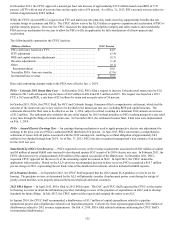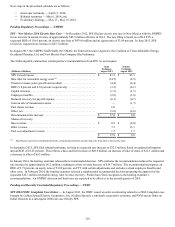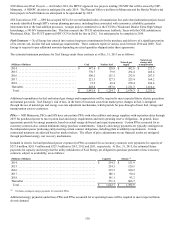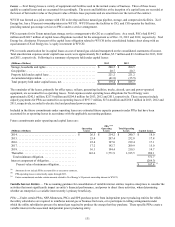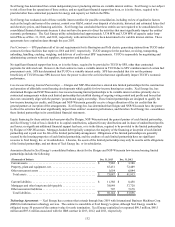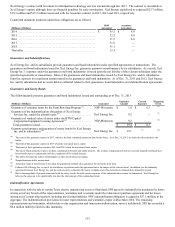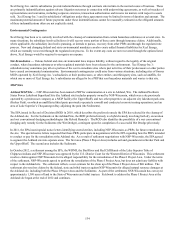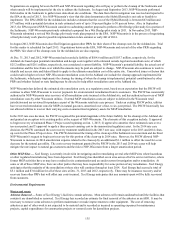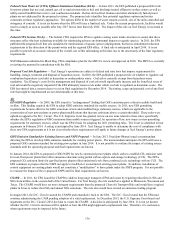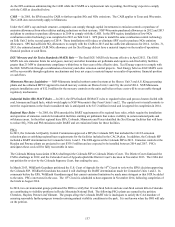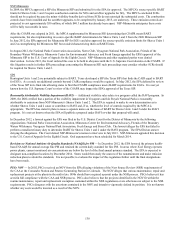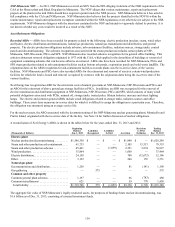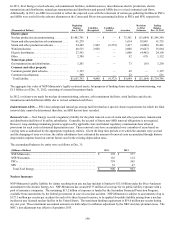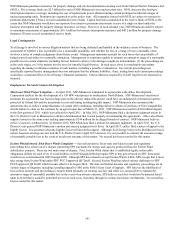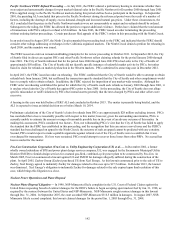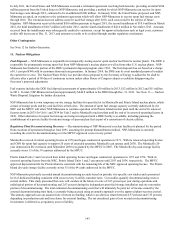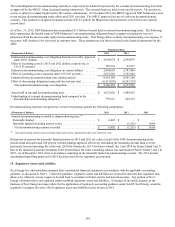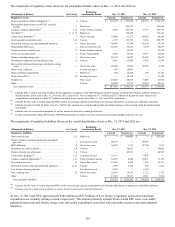Xcel Energy 2013 Annual Report Download - page 153
Download and view the complete annual report
Please find page 153 of the 2013 Xcel Energy annual report below. You can navigate through the pages in the report by either clicking on the pages listed below, or by using the keyword search tool below to find specific information within the annual report.
135
Negotiations are ongoing between the EPA and NSP-Wisconsin regarding who will pay or perform the cleanup of the Sediments and
what remedy will be implemented at the site to address the Sediments. In August and September 2013, NSP-Wisconsin performed
field studies in the Sediments to gather more data about site conditions. The data from that investigation was received and reported to
the EPA at the end of 2013. It is NSP-Wisconsin’s view that this data demonstrates the Hybrid Remedy is not safe or feasible to
implement. The EPA’s ROD for the Ashland site includes estimates that the cost of the Hybrid Remedy is between $63 million and
$77 million, with a potential deviation in such estimated costs of up to 50 percent higher to 30 percent lower. Also, in September
2013, the EPA requested NSP-Wisconsin consider re-submitting another proposal to perform a Wet Dredge pilot study for a portion of
the Sediments. NSP-Wisconsin previously submitted a proposal for a Wet Dredge pilot study in 2011. In November 2013, NSP-
Wisconsin submitted a revised Wet Dredge pilot study work plan proposal to the EPA. NSP-Wisconsin is in the process of negotiating
a final pilot study work plan for possible implementation in late summer or early fall of 2014.
In August 2012, NSP-Wisconsin also filed litigation against other PRPs for their share of the cleanup costs for the Ashland site. Trial
for this matter is scheduled for April 2015. Negotiations between the EPA, NSP-Wisconsin and several of the other PRPs regarding
the PRPs’ fair share of the cleanup costs for the Ashland site are also ongoing.
At Dec. 31, 2013 and 2012, NSP-Wisconsin had recorded a liability of $104.6 million and $103.7 million, respectively, for the
Ashland site based upon potential remediation and design costs together with estimated outside legal and consultant costs; of which
$25.2 million and $20.1 million, respectively, was considered a current liability. NSP-Wisconsin’s potential liability, the actual cost of
remediation and the time frame over which the amounts may be paid are subject to change. NSP-Wisconsin also continues to work to
identify and access state and federal funds to apply to the ultimate remediation cost of the entire site. Unresolved issues or factors that
could result in higher or lower NSP-Wisconsin remediation costs for the Ashland site include the cleanup approach implemented for
the Sediments, which party implements the cleanup, the timing of when the cleanup is implemented, potential contributions by other
PRPs and whether federal or state funding may be directed to help offset remediation costs at the Ashland site.
NSP-Wisconsin has deferred the estimated site remediation costs, as a regulatory asset, based on an expectation that the PSCW will
continue to allow NSP-Wisconsin to recover payments for environmental remediation from its customers. The PSCW has consistently
authorized in NSP-Wisconsin rates recovery of all remediation costs incurred at the Ashland site, and has authorized recovery of MGP
remediation costs by other Wisconsin utilities. External MGP remediation costs are subject to deferral in the Wisconsin retail
jurisdiction and are reviewed for prudence as part of the Wisconsin retail rate case process. Under an existing PSCW policy, utilities
have recovered remediation costs for MGPs in natural gas rates, amortized over a four- to six-year period. The PSCW historically has
not allowed utilities to recover their carrying costs on unamortized regulatory assets for MGP remediation.
In the 2013 rate case decision, the PSCW recognized the potential magnitude of the future liability for the cleanup at the Ashland site
and granted an exception to its existing policy at the request of NSP-Wisconsin. The elements of this exception include: 1) approval
to begin recovery of estimated Phase 1 Project costs beginning on Jan. 1, 2013; 2) approval to amortize these estimated costs over a
ten-year period; and 3) approval to apply a three percent carrying cost to the unamortized regulatory asset. In the 2014 rate case
decision, the PSCW continued the cost recovery treatment established in the 2013 rate case, with respect to the 2013 and 2014 clean-
up costs for the Phase I Project Area. The PSCW determined the timing of the clean-up of the Sediments was uncertain and declined
NSP-Wisconsin’s request to begin cost recovery for this portion of the clean-up in 2014 rates. However, the PSCW allowed NSP-
Wisconsin to increase its 2014 amortization expense related to the clean-up by an additional $1.1 million to offset the need for a rate
decrease for the natural gas utility. The cost recovery treatment granted by the PSCW in the 2013 and 2014 rate cases will help
mitigate the rate impact to natural gas customers and the risk to NSP-Wisconsin from a longer amortization period.
Other MGP Sites — Xcel Energy is currently involved in investigating and/or remediating several other MGP sites where hazardous
or other regulated materials may have been deposited. Xcel Energy has identified seven sites across all of its service territories, where
former MGP activities have or may have resulted in site contamination and are under current investigation and/or remediation. At
some or all of these MGP sites, there are other parties that may have responsibility for some portion of any remediation. Xcel Energy
anticipates that the majority of the remediation at these sites will continue through at least 2014. Xcel Energy had accrued a total of
$5.1 million and $3.0 million for all of these sites at Dec. 31, 2013 and 2012, respectively. There may be insurance recovery and/or
recovery from other PRPs that will offset any costs incurred. Xcel Energy anticipates that any amounts spent will be fully recovered
from customers.
Environmental Requirements
Water and waste
Asbestos Removal — Some of Xcel Energy’s facilities contain asbestos. Most asbestos will remain undisturbed until the facilities that
contain it are demolished or removed. Xcel Energy has recorded an estimate for final removal of the asbestos as an ARO. It may be
necessary to remove some asbestos to perform maintenance or make improvements to other equipment. The cost of removing
asbestos as part of other work is not expected to be material and is recorded as incurred as operating expenses for maintenance
projects, capital expenditures for construction projects or removal costs for demolition projects.


